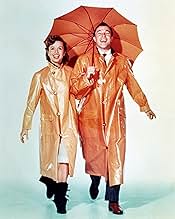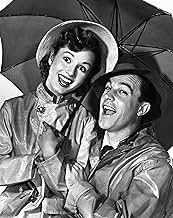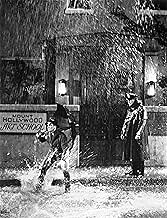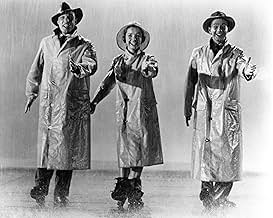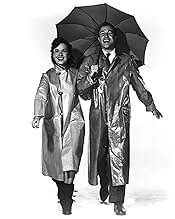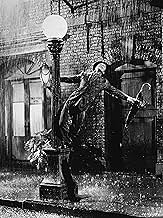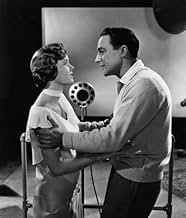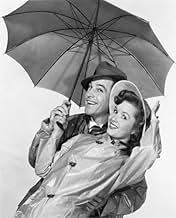Eine Stummfilmproduktionsfirma und deren Schauspieler versuchen, den schwierigen Übergang in die Tonfilmära zu schaffen.Eine Stummfilmproduktionsfirma und deren Schauspieler versuchen, den schwierigen Übergang in die Tonfilmära zu schaffen.Eine Stummfilmproduktionsfirma und deren Schauspieler versuchen, den schwierigen Übergang in die Tonfilmära zu schaffen.
- Regie
- Drehbuch
- Hauptbesetzung
- Für 2 Oscars nominiert
- 11 Gewinne & 11 Nominierungen insgesamt
Dawn Addams
- Teresa - a Lady-in-Waiting
- (Nicht genannt)
John Albright
- Call Boy
- (Nicht genannt)
Shirlee Allard
- Chorus Girl
- (Nicht genannt)
Bebe Allen
- Chorus Girl
- (Nicht genannt)
Sue Allen
- Chorus Girl
- (Nicht genannt)
John Angelo
- Dancer
- (Nicht genannt)
Marie Ardell
- Chorus Girl
- (Nicht genannt)
Bette Arlen
- 'Miss January' in 'Beautiful Girl' segment
- (Nicht genannt)
David Bair
- Chorus Boy
- (Nicht genannt)
Jane Bateman
- Chorus Girl
- (Nicht genannt)
Zusammenfassung
Reviewers say 'Singin' in the Rain' is a celebrated classic, praised for its charm, wit, and infectious energy. Gene Kelly's performance, especially in the title number, is lauded for its seamless blend of dancing, singing, and charisma. The supporting cast, including Debbie Reynolds and Donald O'Connor, is commended for their stellar performances and chemistry. The film's vibrant choreography, clever script, and memorable musical numbers are frequently celebrated. Despite minor criticisms about predictability and humor, it remains a beloved musical.
Empfohlene Bewertungen
Everybody knows Gene Kelly singing and dancing in the films title number, but this is just one of the many magical musical numbers in this epic piece of blissful entertainment. Set during the turbulent period when Hollywood was converting from silent films to sound, Singin' in the Rain' is a perfect example of everything that is good and right about movie-making. Gene Kelly in his greatest role is an all singing, all dancing sensation and his acting is pretty damn good too. Donald O'Connor excels as his exuberant sidekick and almost steals the show with the unsurpassed Make em Laugh'. Debbie Reynolds is feisty and sexy as Kelly's love interest, while Jean Hagen gives one of the screen's greatest supporting performances as the horrid Lena Lamont, a silent screen goddess whose voice will just not cut it in talkies.
The musical numbers flow fast and furious as Gene and Donald perform amazing feats of choreography with Fit as a Fiddle' and Moses Supposes' while Good Mornin' will have you dancing in the aisles. If Singin' in the Rain' had no musical numbers it would still be a contender for the funniest film ever made. The problems with experiments with sound films are painfully funny, and Kelly's silent sparring with the demonic Hagen is hilarious. The accolade of sheer perfection can be conferred on few films, and such a title is perhaps even an understatement in this case. And never before did rain look like so much fun.
The musical numbers flow fast and furious as Gene and Donald perform amazing feats of choreography with Fit as a Fiddle' and Moses Supposes' while Good Mornin' will have you dancing in the aisles. If Singin' in the Rain' had no musical numbers it would still be a contender for the funniest film ever made. The problems with experiments with sound films are painfully funny, and Kelly's silent sparring with the demonic Hagen is hilarious. The accolade of sheer perfection can be conferred on few films, and such a title is perhaps even an understatement in this case. And never before did rain look like so much fun.
It's the magic that seldom appears, whose longevity is perpetual, the pleasure of enjoying the perfections that people, music and great storytelling can sometimes offer, with the backdrop a little piece of cinema history itself. All without foul language, extravagant pyrotechnics, mass brawls and bullets ricocheting all over the place, just immensely talented people doing what they do best - keeping you entertained and allowing you to escape for a while and live with the dreams of others. Whether musicals are you thing or not, there can be no doubt that you witness greatness as you welcome the rain and it makes your heart sing.
Singin' in the Rain is one of the best movies ever made. The film is beautiful, tuneful, and loads of fun. While it pokes fun at Hollywood it also does so with great love. Little bits and pieces of Hollywood lore find their way into this great film and it's a pleasure to get the joke or recognize the real star they're referring to.
The star trio is just perfect: Gene Kelly give a funny performance as the hammy silent actor; Donald O'Connor makes the most of his "second banana" role; Debbie Reynolds is perfect as the ingénue trying to break into films.
The three stars perform many memorable numbers, including Kelly's "Singin' in the Rain" classic; all three in the "Good Mornin'" number; O'Connor's "Make 'Em Laugh"; and Kelly and Reynolds in "You Were Meant for Me." The masterpiece however may be the "Gotta Dance" production number with Kelly and Cyd Charissejust perfect. Also great fun are O'Connor and Kelly in "Fit as a Fiddle" and "Moses Supposes."
There are of course other production numbers, including the montage that shows Hollywood's race to transition to talkies, a scene that ends in the "Beautiful Girl" number featuring Jimmy Thompson.
Jean Hagen (as Lina Lamont) won an Oscar nomination and steals the film in a classic comedy performance. Also good are Millard Mitchell, Douglas Fowley, Rita Moreno, King Donovan, Kathleen Freeman, Mae Clarke, Julius Tannen, and Madge Blake.
The great trick to this film is that while Reynolds is supposedly "lip syncing" for Hagen, it's really Hagen's voice that Reynolds is miming to as in the "I Would, Would You" number. The final miming act is Hagen mouthing "Singin' in the Rain" is really Reynolds. It gets so confusing you can't tell who is lip syncing whose voice.
Lots of Hollywood lore retold in this film. Hagen's Lamont character is a veiled reference to Norma Talmadge, who supposedly failed in talkies because of her New York accent. It's also a reference to Louise Brooks, whose talkie debut in The Canary Murder Case was all dubbed. When Kelly screams "I LOVE YOU" it's a reference to John Gilbert in is talkie debut flop. His Glorious Night. Kathleen Freeman's diction coach character is a reference to Constance Collier, who returned to Hollywood as a coach. And on it goes.
A great film!
The star trio is just perfect: Gene Kelly give a funny performance as the hammy silent actor; Donald O'Connor makes the most of his "second banana" role; Debbie Reynolds is perfect as the ingénue trying to break into films.
The three stars perform many memorable numbers, including Kelly's "Singin' in the Rain" classic; all three in the "Good Mornin'" number; O'Connor's "Make 'Em Laugh"; and Kelly and Reynolds in "You Were Meant for Me." The masterpiece however may be the "Gotta Dance" production number with Kelly and Cyd Charissejust perfect. Also great fun are O'Connor and Kelly in "Fit as a Fiddle" and "Moses Supposes."
There are of course other production numbers, including the montage that shows Hollywood's race to transition to talkies, a scene that ends in the "Beautiful Girl" number featuring Jimmy Thompson.
Jean Hagen (as Lina Lamont) won an Oscar nomination and steals the film in a classic comedy performance. Also good are Millard Mitchell, Douglas Fowley, Rita Moreno, King Donovan, Kathleen Freeman, Mae Clarke, Julius Tannen, and Madge Blake.
The great trick to this film is that while Reynolds is supposedly "lip syncing" for Hagen, it's really Hagen's voice that Reynolds is miming to as in the "I Would, Would You" number. The final miming act is Hagen mouthing "Singin' in the Rain" is really Reynolds. It gets so confusing you can't tell who is lip syncing whose voice.
Lots of Hollywood lore retold in this film. Hagen's Lamont character is a veiled reference to Norma Talmadge, who supposedly failed in talkies because of her New York accent. It's also a reference to Louise Brooks, whose talkie debut in The Canary Murder Case was all dubbed. When Kelly screams "I LOVE YOU" it's a reference to John Gilbert in is talkie debut flop. His Glorious Night. Kathleen Freeman's diction coach character is a reference to Constance Collier, who returned to Hollywood as a coach. And on it goes.
A great film!
Don Lockwood (Gene Kelly) and Lina Lamont (Jean Hagen) are a famed Hollywood duo, making films at the tail end of the silent era. The studio has been issuing PR suggesting that they're a romantic item. In reality, they can barely stand one another. One night, while on the town with his best friend Cosmo Brown (Donald O' Connor), Lockwood has to run to escape fans who want a piece of him badly enough that they'll literally rip his clothes to shreds. He hops over a number of moving vehicles and ends up in the passenger seat of Kathy Selden's (Debbie Reynolds) car. Lockwood seems immediately taken with her, but she gives him the cold shoulder. She says she's an actress with a love of theater, and she looks down on film acting. Later, Lockwood discovers that she was inflating the truth a bit, as he sees Selden performing as a cute song & dance girl at an industry party he's attending. She runs out of the party and Lockwood chases after her, but he's too late. While he tries to track her down, he, Lamont and their studio have to deal with the changing nature of film in 1927--made much more difficult by the fact that Lamont may look glamorous, but she talks more like Fran Drescher in "The Nanny" (1993).
Aside from the more serious aspects of the plot, Singing in the Rain is a great success as a romance and a musical. It also has an astoundingly rich Technicolor look, and it is charmingly humorous. Kelly and Reynolds click on screen, even if offscreen Kelly, who also co-directed and co-choreographed, was famously difficult to work with--he drove Reynolds so hard (she was a much more inexperienced dancer) that her feet literally started bleeding at one point. The songs are great, they're worked into the story well--which is perhaps surprising given that most of them weren't written specifically for this film--and the choreography is impeccable, frequently jaw dropping and always aesthetically wondrous and sublime. If for nothing else, the film is worth a look for its often-athletic dance numbers, which can resemble Jackie Chan's showy martial arts stunts as much as dancing. It's also imperative viewing for cultural literacy in the realm of film.
But the more serious aspects of the plot are fascinating as well. In a significant way, Singing in the Rain is about film technology. Film technology is the hinge of the plot, after all. The climax and dénouement are decided by the advent of synchronized sound in the film industry. We see studio head R.F. Simpson (Millard Mitchell) demonstrating sound films at the party where Lockwood sees Selden for the second time, providing two big turning points at once. There are sequences of actors heading off to diction coaches, as happened in reality once sound entered the scene, and also in reality as in the film some actor's careers were jeopardized by having to suddenly master a new skill.
But Singing in the Rain is about technology on another level, too. Kelly and co-director Stanley Donen go to great lengths to ensure that the film is an exemplar of state-of-the-art film technology in 1952. For example, the beautiful Technicolor cinematography is emphasized by the fabulously colorful costumes and production design--they're showing off cutting edge color. The sound is as good as it could be in 1952, and the fact that this is a musical helps show that off. The sets and effects are complex and an attempt is made to show them off as well.
Donen and Kelly often play up the artificiality of the sets and effects to emphasize artistry and technology. This is clearly shown in the "Make 'Em Laugh" sequence (and surrounding events) and the extended "Broadway Rhythm Ballet" sequence with Cyd Charisse. Showing off this artistry and technology also occurs very subtly, as with the rain in the "Singing in the Rain" sequence. Even today, rain machines are frequently employed in a way that it appears to be raining on film, but in reality, it's just enough coverage to produce the illusion. In the "Singing in the Rain" sequence, they make sure that you can see the whole area is getting flooded, and they use Gene Kelly's umbrella, as torrents of water bounce off of it, to emphasize that no matter where he goes, "rain" is pouring down on him.
While there are many musicals I like as much as Singing in The Rain, this is one of the better-loved examples of that genre, and for good reason. Any musical lover has surely seen this already, and if not, they should run out now and pick it up on DVD. If you're relatively unfamiliar with classic Hollywood musicals, this is one of the best places to start.
Aside from the more serious aspects of the plot, Singing in the Rain is a great success as a romance and a musical. It also has an astoundingly rich Technicolor look, and it is charmingly humorous. Kelly and Reynolds click on screen, even if offscreen Kelly, who also co-directed and co-choreographed, was famously difficult to work with--he drove Reynolds so hard (she was a much more inexperienced dancer) that her feet literally started bleeding at one point. The songs are great, they're worked into the story well--which is perhaps surprising given that most of them weren't written specifically for this film--and the choreography is impeccable, frequently jaw dropping and always aesthetically wondrous and sublime. If for nothing else, the film is worth a look for its often-athletic dance numbers, which can resemble Jackie Chan's showy martial arts stunts as much as dancing. It's also imperative viewing for cultural literacy in the realm of film.
But the more serious aspects of the plot are fascinating as well. In a significant way, Singing in the Rain is about film technology. Film technology is the hinge of the plot, after all. The climax and dénouement are decided by the advent of synchronized sound in the film industry. We see studio head R.F. Simpson (Millard Mitchell) demonstrating sound films at the party where Lockwood sees Selden for the second time, providing two big turning points at once. There are sequences of actors heading off to diction coaches, as happened in reality once sound entered the scene, and also in reality as in the film some actor's careers were jeopardized by having to suddenly master a new skill.
But Singing in the Rain is about technology on another level, too. Kelly and co-director Stanley Donen go to great lengths to ensure that the film is an exemplar of state-of-the-art film technology in 1952. For example, the beautiful Technicolor cinematography is emphasized by the fabulously colorful costumes and production design--they're showing off cutting edge color. The sound is as good as it could be in 1952, and the fact that this is a musical helps show that off. The sets and effects are complex and an attempt is made to show them off as well.
Donen and Kelly often play up the artificiality of the sets and effects to emphasize artistry and technology. This is clearly shown in the "Make 'Em Laugh" sequence (and surrounding events) and the extended "Broadway Rhythm Ballet" sequence with Cyd Charisse. Showing off this artistry and technology also occurs very subtly, as with the rain in the "Singing in the Rain" sequence. Even today, rain machines are frequently employed in a way that it appears to be raining on film, but in reality, it's just enough coverage to produce the illusion. In the "Singing in the Rain" sequence, they make sure that you can see the whole area is getting flooded, and they use Gene Kelly's umbrella, as torrents of water bounce off of it, to emphasize that no matter where he goes, "rain" is pouring down on him.
While there are many musicals I like as much as Singing in The Rain, this is one of the better-loved examples of that genre, and for good reason. Any musical lover has surely seen this already, and if not, they should run out now and pick it up on DVD. If you're relatively unfamiliar with classic Hollywood musicals, this is one of the best places to start.
10AlsExGal
Singin In the Rain is arguably the best movie musical of all time, not just because of the music but because of the entire package - the premise, the comedy, the characters - everything here works together to make you feel better any time you sit down to watch it. It's ironic that this movie was thrown together quickly to capitalize on the success of "An American in Paris", since the improvisational feeling of the movie is one of the things that makes it so much fun. Although this film is number ten on the top 100 films of all time as compiled by the American Film Institute, it wasn't nominated for best picture the year of its release, 1952. Although it did well at the box office, it would be over twenty years before people would look back and realize just what a great motion picture it was. Perhaps that was because the 1970's were such bleak and cynical years, with movies that largely matched that mood, that people were eager to rediscover the fun that a motion picture viewing experience could be.
The movie focuses on that period of time in which the entire motion picture film industry was in nervous transition from silent to talking pictures. Although the movie compresses time in this respect - the transition actually took about three years - it does accurately describe the technical problems of that era along with their comical aspects. There was an overabundance of musicals in the first batch of talking films, many stars did have heavy accents that made their speech undecipherable or voices that came across like nails on a chalkboard like Lina Lamont (Jean Hagen) and saw their careers ruined, and early sound technology itself was so fragile that you would often see actors speaking to potted plants or to coat racks with comic effect. The preview of silent picture team Lockwood and Lamont's first talkie, "The Dueling Cavalier", is one of the most hilarious scenes in the film. It is pretty typical of what you would see in such an early talking picture - dialogue going in and out of sync, actors and actresses strutting around and wildly gesturing as if nobody can hear them, and dialogue that still resembled what you would read off of the title cards in a silent film - "I love you, I love you, I love you".
All of this is one of the reasons Singin' In The Rain will never get dated - it is a comic nostalgic look at a very narrow period in time. This movie is fun outside of its comic take on movie history, though. For one, it's hard to say who steals the show the most, since there are so many thieves involved. Most notably there is Jean Hagen - who actually has a very pleasant speaking voice - as the evil silent star who can't accept her days are numbered. Then there is a 27 year-old Donald O'Connor as Cosmo, the studio music director and sidekick of Gene Kelly's character whose youthful exuberance really shines in the number "Make 'Em Laugh" along with all of his goofy facial expressions. He seems to be having as much fun as the audience. Finally, there are all of the great dance numbers and music, capped by probably one of the most famous scenes of all time - Gene Kelly's rendition of the title number that perfectly captures the joy of a man who has just fallen in love and feels he has the world at his feet. You just can't watch this film and not come away with a smile on your face. It is as good for the soul as chicken soup, just a lot more fun.
The movie focuses on that period of time in which the entire motion picture film industry was in nervous transition from silent to talking pictures. Although the movie compresses time in this respect - the transition actually took about three years - it does accurately describe the technical problems of that era along with their comical aspects. There was an overabundance of musicals in the first batch of talking films, many stars did have heavy accents that made their speech undecipherable or voices that came across like nails on a chalkboard like Lina Lamont (Jean Hagen) and saw their careers ruined, and early sound technology itself was so fragile that you would often see actors speaking to potted plants or to coat racks with comic effect. The preview of silent picture team Lockwood and Lamont's first talkie, "The Dueling Cavalier", is one of the most hilarious scenes in the film. It is pretty typical of what you would see in such an early talking picture - dialogue going in and out of sync, actors and actresses strutting around and wildly gesturing as if nobody can hear them, and dialogue that still resembled what you would read off of the title cards in a silent film - "I love you, I love you, I love you".
All of this is one of the reasons Singin' In The Rain will never get dated - it is a comic nostalgic look at a very narrow period in time. This movie is fun outside of its comic take on movie history, though. For one, it's hard to say who steals the show the most, since there are so many thieves involved. Most notably there is Jean Hagen - who actually has a very pleasant speaking voice - as the evil silent star who can't accept her days are numbered. Then there is a 27 year-old Donald O'Connor as Cosmo, the studio music director and sidekick of Gene Kelly's character whose youthful exuberance really shines in the number "Make 'Em Laugh" along with all of his goofy facial expressions. He seems to be having as much fun as the audience. Finally, there are all of the great dance numbers and music, capped by probably one of the most famous scenes of all time - Gene Kelly's rendition of the title number that perfectly captures the joy of a man who has just fallen in love and feels he has the world at his feet. You just can't watch this film and not come away with a smile on your face. It is as good for the soul as chicken soup, just a lot more fun.
Wusstest du schon
- WissenswertesFor the "Make 'em Laugh" number, Donald O'Connor revived a trick he had done as a young dancer: running up a wall and completing a somersault. The number was so physically taxing that O'Connor ended up in a hospital bed for a week after its completion. He suffered from exhaustion and carpet burns. After an accident ruined all of the initial footage, O'Connor agreed to do the difficult number all over again.
- PatzerDuring the Cyd Charisse nightclub dance number, when she's wrapped around Gene Kelly, her body completely changes position between frames due to a clumsy edit. According to commentary on the special edition DVD, this cut of only a few frames' duration dates back to the original release of the film and no one knows why it exists.
- Zitate
Cosmo Brown: Lina. She can't act, she can't sing, she can't dance. A triple threat.
- VerbindungenEdited from Die drei Musketiere (1948)
- SoundtracksFit as a Fiddle
(1932)
Music by Al Hoffman (uncredited) and Al Goodhart (uncredited)
Lyrics by Arthur Freed
Originally from the 1932 stage revue "George White's Music Hall Varieties"
Sung by Gene Kelly (uncredited) and Donald O'Connor (uncredited)
Top-Auswahl
Melde dich zum Bewerten an und greife auf die Watchlist für personalisierte Empfehlungen zu.
- How long is Singin' in the Rain?Powered by Alexa
- What is 'Singin' in the Rain' about?
- Is 'Singin' in the Rain' based on a book?
- What was the real first full-length 'talkie'?
Details
- Erscheinungsdatum
- Herkunftsland
- Sprache
- Auch bekannt als
- Cantando bajo la lluvia
- Drehorte
- Metro-Goldwyn-Mayer Studios - 10202 W. Washington Blvd., Culver City, Kalifornien, USA(New York City Streets)
- Produktionsfirma
- Weitere beteiligte Unternehmen bei IMDbPro anzeigen
Box Office
- Budget
- 2.540.800 $ (geschätzt)
- Bruttoertrag in den USA und Kanada
- 1.884.537 $
- Eröffnungswochenende in den USA und in Kanada
- 13.643 $
- 10. Nov. 2002
- Weltweiter Bruttoertrag
- 2.096.442 $
- Laufzeit1 Stunde 43 Minuten
- Farbe
- Sound-Mix
- Seitenverhältnis
- 1.37 : 1
Zu dieser Seite beitragen
Bearbeitung vorschlagen oder fehlenden Inhalt hinzufügen

Oberste Lücke
By what name was Du sollst mein Glücksstern sein (1952) officially released in India in Hindi?
Antwort






